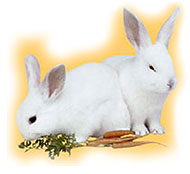Rabbits may be easy to love, but
they're not quite as easy to care for. Rabbits are social creatures and wonderful
companions to people who take the time to learn about their needs. This set of quick
reminders will give you the basics. |
 |
Help Them Hop to It:
Just because rabbits are little doesn't mean they don't need room to roam. A cage or a run
for a six-pound rabbit should be at least 18 inches high, 24 inches wide, and 24 inches
deep. Cages with wire flooring are hard on rabbits' feet, which do not have protective
pads like those of dogs and cats. If you place your rabbit in a wire cage, be sure to
layer the floor with cardboard or paper. Place a cardboard box in the cage so the bunny
has a comfortable place to hide, and respect the animals' need for quiet time. (Rabbits
usually sleep during the day and night, becoming playful at dawn and dusk.) Always
house rabbits indoors and maintain comfortable room temperatures, as rabbits
do not tolerate extreme temperatures.
|
|
Please Put Litter in Its
Place:
Rabbits can easily learn to use a litter box. Place a litter box in the cage to
encourage this behavior. When creating a litter box or bedding, stay away from cedar or
other wood shavings, which may cause liver damage or trigger allergic reactions in
rabbits. Instead, stick with organic litters made of paper, oats, alfalfa, or citrus. Hay
is another option for litter material, but it requires even more frequent changing because
rabbits will nibble on it.
Give 'Em Hay:
If there were a food pyramid chart created for rabbits, timothy grass hay would form the
entire base. Rabbits should have access to a constant supply of this hay, which aids their
digestive systems and provides the necessary fiber to help prevent health problems such as
hair balls, diarrhea, and obesity. Alfalfa hay, on the other hand, should be given to
adult rabbits in limited quantities because it's too high in protein, calcium, and
calories.
A Balanced Diet:
In addition to hay, the basic diet of a mature rabbit should include leafy green
vegetables such as parsley, dandelion greens, and carrot tops; one to two tablespoons per
day of treats such as rolled oats, unsalted crackers, dry bread, or fruit; and a good
pellet feed with 12 to 20% crude fiber and 14 to 17% crude protein (check the packaging).
Begin feeding pellets at one-fourth cup per five pounds of body weight, divided into two
meals per day, and then adjust the amount according to the rabbit's body condition. Avoid
lettuce, tomatoes, cabbage, or table scraps, which can all cause bloat and diarrhea. Keep
fresh water available, preferably in sipper bottles, which take up less space than water
bowls and are less likely to spill. Watch new rabbits to make sure they know how to use
the bottles, and clean bottles daily so the tubes don't get clogged.
Chew on This:
Chewing is part of a rabbit's natural behavior, but it doesn't have to be destructive. To
keep rabbits active and amused, you may want to put untreated wood blocks or cardboard in
their cage. Your best bet is paper-towel rolls, toilet-paper rolls, and other chewable
cardboard materials that can be tossed in the trash once they've served their
purpose. Avoid plastic toys and objects with sharp edges, loose parts, or soft rubber that
rabbits could chew into pieces and swallow.
Caution: Handle With Care:
Rabbits are fragile animals who should be handled carefully. Their bones are so delicate
that the muscles in their powerful hind legs can easily overcome the strength of their
skeletons. As a result, if not properly restrained, struggling rabbits can break their own
spines.
One way to take a rabbit out of a cage is to gently gather a handful of loose skin at the
scruff of his neck, turn the animal's face away while pulling his body toward you, and
immediately place your other hand underneath his rump to support his body weight. Another
method is to slide one hand underneath the front of the rabbit and the other hand
underneath his back side, lifting him carefully with both hands. Whichever method you use,
make sure you never let his body hang free, never lift him by the stomach, and never pick
him up by his ears.
And remember that because rabbits groom each other around the eyes, ears, top of the nose,
top of the head, and down the back, they'll think of you as a kindred spirit if you pat
them there, too.
|
|

